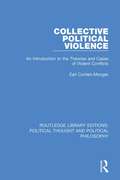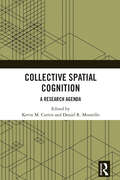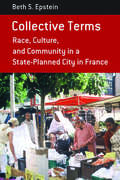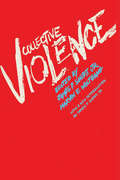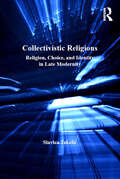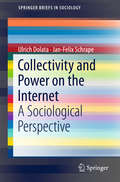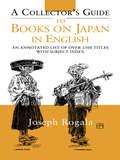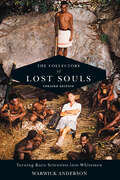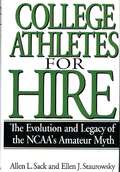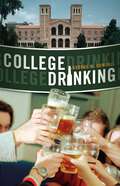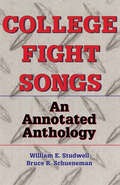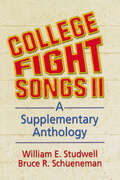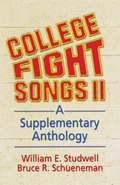- Table View
- List View
Collective Political Violence: An Introduction to the Theories and Cases of Violent Conflicts (Routledge Library Editions: Political Thought and Political Philosophy #16)
by Earl Conteh-MorganFirst published in 2004. Collective Political Violence is a concise, but thorough, interdisciplinary analysis of the many competing concepts, theories, and explanations of political conflict, including revolutions, civil wars, genocide, and terrorism. To further his examination of each type of conflict, Earl Conteh-Morgan presents case studies, from the Rwandan genocide to the civil rights movement in the United States. Along the way, he illuminates new debates concerning terrorism, peacekeeping, and environmental security. Written in a knowledgeable, yet accessible, manner, Collective Political Violence treats the issue of political violence with on impressively wide geographic range, and successfully straddles the ideological divide.
Collective Political Violence: An Introduction to the Theories and Cases of Violent Conflicts (Routledge Library Editions: Political Thought and Political Philosophy #16)
by Earl Conteh-MorganFirst published in 2004. Collective Political Violence is a concise, but thorough, interdisciplinary analysis of the many competing concepts, theories, and explanations of political conflict, including revolutions, civil wars, genocide, and terrorism. To further his examination of each type of conflict, Earl Conteh-Morgan presents case studies, from the Rwandan genocide to the civil rights movement in the United States. Along the way, he illuminates new debates concerning terrorism, peacekeeping, and environmental security. Written in a knowledgeable, yet accessible, manner, Collective Political Violence treats the issue of political violence with on impressively wide geographic range, and successfully straddles the ideological divide.
Collective Spatial Cognition: A Research Agenda
by Kevin M. Curtin Daniel R. MontelloThis book integrates the science of spatial cognition and the science of team cognition to explore the social, psychological, and behavioral phenomenon of spatial cognition as it occurs in human collectives such as dyads and work teams.It represents the culmination of a process of outlining and defining a growing field of research termed Collective Spatial Cognition. It engages contributions from an international and multi-disciplinary community of scholars, who have collaborated to provide a foundation for knowledge discovery regarding how groups of people of varying size acquire information and solve problems involving spatiality as a key component, leading to action that incorporates the spatial information and problem-solving collectively achieved. The collectives under study can be as small as dyads (teams of two) to large teams-of-teams who are working alongside each other to complete a mutual goal. The book lays the foundation for multi- and interdisciplinary work regarding Collective Spatial Cognition in the years to come, and this book documents that foundation.This book will be of interest to those researching spatial, behavioural, cognitive, and information sciences in the fields of human geography, sociology, psychology, and computer science.
Collective Spatial Cognition: A Research Agenda
by Kevin Curtin Daniel R. MontelloThis book integrates the science of spatial cognition and the science of team cognition to explore the social, psychological, and behavioral phenomenon of spatial cognition as it occurs in human collectives such as dyads and work teams.It represents the culmination of a process of outlining and defining a growing field of research termed Collective Spatial Cognition. It engages contributions from an international and multi-disciplinary community of scholars, who have collaborated to provide a foundation for knowledge discovery regarding how groups of people of varying size acquire information and solve problems involving spatiality as a key component, leading to action that incorporates the spatial information and problem-solving collectively achieved. The collectives under study can be as small as dyads (teams of two) to large teams-of-teams who are working alongside each other to complete a mutual goal. The book lays the foundation for multi- and interdisciplinary work regarding Collective Spatial Cognition in the years to come, and this book documents that foundation.This book will be of interest to those researching spatial, behavioural, cognitive, and information sciences in the fields of human geography, sociology, psychology, and computer science.
Collective Terms: Race, Culture, and Community in a State-Planned City in France (Berghahn Monographs in French Studies #10)
by Beth S. EpsteinThe banlieue, the mostly poor and working-class suburbs located on the outskirts of major cities in France, gained international media attention in late 2005 when riots broke out in some 250 such towns across the country. Pitting first- and second-generation immigrant teenagers against the police, the riots were an expression of the multiplicity of troubles that have plagued these districts for decades. This study provides an ethnographic account of life in a Parisian banlieue and examines how the residents of this multiethnic city come together to build, define, and put into practice their collective life. The book focuses on the French ideal of integration and its consequences within the multicultural context of contemporary France. Based on research conducted in a state-planned ville nouvelle, or New Town, the book also provides a view on how the French state has used urban planning to shore up national priorities for social integration. Collective Terms proposes an alternative reading of French multiculturalism, suggesting fresh ways for thinking through the complex mix of race, class, nation, and culture that increasingly defines the modern urban experience.
Collective Trauma and the Psychology of Secrets in Transnational Film (Routledge Advances in Film Studies)
by Deborah Lynn PorterCollective Trauma and the Psychology of Secrets in Transnational Film advances a methodological line of inquiry based on a fresh insight into the ways in which cinematic meaning is generated and can be ascertained. Premised on a critical reading strategy informed by a metapsychology of secrets, the book features analyses of internationally acclaimed films—Guillermo del Torro’s Pan’s Labyrinth, Andrey Zvyagintsev’s The Return, Jee-woon Kim’s A Tale of Two Sisters, and Alejandro Amenábar’s The Others. It demonstrates how a rethinking of the figure of the secret in national film yields a new vantage point for examining heretofore unrecognized connections between collective historical experience, cinematic production and a transnational aesthetic of concealment and hiding.
Collective Trauma and the Psychology of Secrets in Transnational Film (Routledge Advances in Film Studies)
by Deborah Lynn PorterCollective Trauma and the Psychology of Secrets in Transnational Film advances a methodological line of inquiry based on a fresh insight into the ways in which cinematic meaning is generated and can be ascertained. Premised on a critical reading strategy informed by a metapsychology of secrets, the book features analyses of internationally acclaimed films—Guillermo del Torro’s Pan’s Labyrinth, Andrey Zvyagintsev’s The Return, Jee-woon Kim’s A Tale of Two Sisters, and Alejandro Amenábar’s The Others. It demonstrates how a rethinking of the figure of the secret in national film yields a new vantage point for examining heretofore unrecognized connections between collective historical experience, cinematic production and a transnational aesthetic of concealment and hiding.
Collective Violence
by James F., Short Marvin E. WolfgangCollective violence has played an important role throughout American history, though we have typically denied it. But it is not enough to repress violence or to suppress our knowledge of it. We must understand the phenomenon, and to do this, we must learn what violent groups are trying to say. Th at some choose violence tells us something about the perpetrators, inevitably, about ourselves and the society we have built.
Collective Violence
by James F., Short Marvin E. WolfgangCollective violence has played an important role throughout American history, though we have typically denied it. But it is not enough to repress violence or to suppress our knowledge of it. We must understand the phenomenon, and to do this, we must learn what violent groups are trying to say. Th at some choose violence tells us something about the perpetrators, inevitably, about ourselves and the society we have built.
Collective Violence, Democracy and Protest Policing (Routledge Studies in Crime and Society)
by David R MansleyIn this book David Mansley argues that the frequency with which violence intrudes on to the streets is related to both how society is governed and how it is policed. With the help of an innovative methodology, he quantifies and tests three variables – collective violence, democracy and protest policing – using protests in Great Britain in 1999–2011, for his sampling frame. The result is the design of new tools of measurement and a harvest of new data, including previously unpublished details of banning orders and riot damages, that enable us to reflect, with the benefit of broad sociological perspective, on the causes of contemporary violent events. Mansley’s explanation of the trends he identifies draws from the work of the best thinkers on violence – especially Charles Tilly, Thomas Hobbes and Norbert Elias. He shows how the style of protest policing and the depth of democracy, both of which function under the direction of the political economy, are crucial to the state’s credentials as the monopoly supplier of legitimate violence. His discussion touches on such current topics as the institution of police commissioners, the privatisation of policing duties, and the decline in homicide. This cultured study, which includes an engaging review of the existing scholarship on violence, is essential material for undergraduate and postgraduate students reading criminology, sociology or political theory.
Collective Violence, Democracy and Protest Policing (Routledge Studies in Crime and Society)
by David R MansleyIn this book David Mansley argues that the frequency with which violence intrudes on to the streets is related to both how society is governed and how it is policed. With the help of an innovative methodology, he quantifies and tests three variables – collective violence, democracy and protest policing – using protests in Great Britain in 1999–2011, for his sampling frame. The result is the design of new tools of measurement and a harvest of new data, including previously unpublished details of banning orders and riot damages, that enable us to reflect, with the benefit of broad sociological perspective, on the causes of contemporary violent events. Mansley’s explanation of the trends he identifies draws from the work of the best thinkers on violence – especially Charles Tilly, Thomas Hobbes and Norbert Elias. He shows how the style of protest policing and the depth of democracy, both of which function under the direction of the political economy, are crucial to the state’s credentials as the monopoly supplier of legitimate violence. His discussion touches on such current topics as the institution of police commissioners, the privatisation of policing duties, and the decline in homicide. This cultured study, which includes an engaging review of the existing scholarship on violence, is essential material for undergraduate and postgraduate students reading criminology, sociology or political theory.
Collectivistic Religions: Religion, Choice, and Identity in Late Modernity
by Slavica JakelicCollectivistic Religions draws upon empirical studies of Christianity in Europe to address questions of religion and collective identity, religion and nationalism, religion and public life, and religion and conflict. It moves beyond the attempts to tackle such questions in terms of 'choice' and 'religious nationalism' by introducing the notion of 'collectivistic religions' to contemporary debates surrounding public religions. Using a comparison of several case studies, this book challenges the modernist bias in understanding of collectivistic religions as reducible to national identities. A significant contribution to both the study of religious change in contemporary Europe and the theoretical debates that surround religion and secularization, it will be of key interest to scholars across a range of disciplines, including sociology, political science, religious studies, and geography.
Collectivistic Religions: Religion, Choice, and Identity in Late Modernity
by Slavica JakelicCollectivistic Religions draws upon empirical studies of Christianity in Europe to address questions of religion and collective identity, religion and nationalism, religion and public life, and religion and conflict. It moves beyond the attempts to tackle such questions in terms of 'choice' and 'religious nationalism' by introducing the notion of 'collectivistic religions' to contemporary debates surrounding public religions. Using a comparison of several case studies, this book challenges the modernist bias in understanding of collectivistic religions as reducible to national identities. A significant contribution to both the study of religious change in contemporary Europe and the theoretical debates that surround religion and secularization, it will be of key interest to scholars across a range of disciplines, including sociology, political science, religious studies, and geography.
Collectivity and Power on the Internet: A Sociological Perspective (SpringerBriefs in Sociology)
by Ulrich Dolata Jan-Felix SchrapeThis book provides a comprehensive overview of the manifestations and interrelations of collectivity and power on the internet from a sociological point of view. It addresses questions on how different forms of internet-based collectivities (masses, crowds, movements, communities ) could be understood and differentiated from one another. It presents analyses on the role technical infrastructures of the web play for their formation, how the mobilization and organization of social movements and social protests has changed through social media, how work and decision-making processes are organized in open source communities and why the essential segments of the commercial internet are today concentrated in the hands of a few corporations who dispose over significant economic, infrastructural and rule-setting power.
A Collector's Guide to Books on Japan in English: An Annotated List of Over 2500 Titles with Subject Index
by Jozef RogalaProvides an invaluable and very accessible addition to existing biographic sources and references, not least because of the supporting biographies of major writers and the historical and cultural notes provided.
A Collector's Guide to Books on Japan in English: An Annotated List of Over 2500 Titles with Subject Index
by Jozef RogalaProvides an invaluable and very accessible addition to existing biographic sources and references, not least because of the supporting biographies of major writers and the historical and cultural notes provided.
The Collectors of Lost Souls: Turning Kuru Scientists into Whitemen
by Warwick AndersonWinner, William H. Welch Medal, American Association for the History of MedicineWinner, Ludwik Fleck Prize, Society for Social Studies of ScienceWinner, General History Award, New South Wales Premier's History AwardsWhen whites first encountered the Fore people in the isolated highlands of colonial New Guinea during the 1940s and 1950s, they found a people in the grip of a bizarre epidemic. Women and children succumbed to muscle weakness, uncontrollable tremors, and lack of coordination, until death inevitably supervened. Facing extinction, the Fore attributed their unique and terrifying affliction to a particularly malign form of sorcery.In The Collectors of Lost Souls, Warwick Anderson tells the story of the resilience of the Fore through this devastating plague, their transformation into modern people, and their compelling attraction for a throng of eccentric and adventurous scientists and anthropologists. Battling competing scientists and the colonial authorities, the brilliant and troubled American doctor D. Carleton Gajdusek determined that the cause of the epidemic—kuru—was a new and mysterious agent of infection, which he called a slow virus (now called a prion). Anthropologists and epidemiologists soon realized that the Fore practice of eating their loved ones after death had spread the slow virus. Though the Fore were never convinced, Gajdusek received the Nobel Prize for his discovery. Now revised and updated, the book includes an extensive new afterword that situates its impact within the fields of science and technology studies and the history of science. Additionally, the author now reflects on his long engagement with the scientists and the people afflicted, describing what has happened to them since the end of kuru. This astonishing story links first-contact encounters in New Guinea with laboratory experiments in Bethesda, Maryland; sorcery with science; cannibalism with compassion; and slow viruses with infectious proteins, reshaping our understanding of what it means to do science.
The Collectors of Lost Souls: Turning Kuru Scientists into Whitemen
by Warwick AndersonWinner, William H. Welch Medal, American Association for the History of MedicineWinner, Ludwik Fleck Prize, Society for Social Studies of ScienceWinner, General History Award, New South Wales Premier's History AwardsWhen whites first encountered the Fore people in the isolated highlands of colonial New Guinea during the 1940s and 1950s, they found a people in the grip of a bizarre epidemic. Women and children succumbed to muscle weakness, uncontrollable tremors, and lack of coordination, until death inevitably supervened. Facing extinction, the Fore attributed their unique and terrifying affliction to a particularly malign form of sorcery.In The Collectors of Lost Souls, Warwick Anderson tells the story of the resilience of the Fore through this devastating plague, their transformation into modern people, and their compelling attraction for a throng of eccentric and adventurous scientists and anthropologists. Battling competing scientists and the colonial authorities, the brilliant and troubled American doctor D. Carleton Gajdusek determined that the cause of the epidemic—kuru—was a new and mysterious agent of infection, which he called a slow virus (now called a prion). Anthropologists and epidemiologists soon realized that the Fore practice of eating their loved ones after death had spread the slow virus. Though the Fore were never convinced, Gajdusek received the Nobel Prize for his discovery. Now revised and updated, the book includes an extensive new afterword that situates its impact within the fields of science and technology studies and the history of science. Additionally, the author now reflects on his long engagement with the scientists and the people afflicted, describing what has happened to them since the end of kuru. This astonishing story links first-contact encounters in New Guinea with laboratory experiments in Bethesda, Maryland; sorcery with science; cannibalism with compassion; and slow viruses with infectious proteins, reshaping our understanding of what it means to do science.
College Athletes for Hire: The Evolution and Legacy of the NCAA's Amateur Myth (Non-ser.)
by Allen L. Sack Ellen J. StaurowskyMany books have been written on the evils of commercialism in college sport, and the hypocrisy of payments to athletes from alumni and other sources outside the university. Almost no attention, however, has been given to the way that the National Collegiate Athletic Association has embraced professionalism through its athletic scholarship policy. Because of this gap in the historical record, the NCAA is often cast as an embattled defender of amateurism, rather than as the architect of a nationwide money-laundering scheme.Sack and Staurowsky show that the NCAA formally abandoned amateurism in the 1950s and passed rules in subsequent years that literally transformed scholarship athletes into university employees. In addition, by purposefully fashioning an amateur mythology to mask the reality of this employer-employee relationship, the NCAA has done a disservice to student-athletes and to higher education. A major subtheme is that women, such as those who created the Association for Intercollegiate Athletics for Women (AIAW), opposed this hypocrisy, but lacked the power to sustain an alternative model. After tracing the evolution of college athletes into professional entertainers, and the harmful effects it has caused, the authors propose an alternative approach that places college sport on a firm educational foundation and defend the rights of both male and female college athletes. This is a provocative analysis for anyone interested in college sports in America and its subversion of traditional educational and amateur principles.
College Drinking: Reframing a Social Problem (Non-ser.)
by George W. DowdallDrinking has become recognized as one of the most important problems facing today's college student. Even though college drinking has increased only modestly over the past few decades, concern about its health, behavioral, and safety consequences has risen rapidly. This book examines college drinking as a social problem within higher education, based on interviews with many leading figures engaged in addressing the problem. It assesses the evidence about how many students drink or drink excessively, and what kinds of behavioral and health problems they have as a consequence. The book answers the crucial questions of why students drink and what mixture of personal and environmental factors shape college drinking. The complex links to campus crime and sexual assault are discussed fully. Key practical questions about effective prevention programs and countermeasures are answered in detail. Students and parents can take action to lower the risk of binge drinking by consulting an appendix, which explains how to use college guide data on 400 leading institutions or data about alcohol violations and crime available for several thousand colleges. Anyone concerned with higher education today will find a full discussion of the scope of the problem and what can be done about it.
The College Fear Factor: How Students amd Professors Misunderstand One Another
by Rebecca D. CoxThey’re not the students strolling across the bucolic liberal arts campuses where their grandfathers played football. They are first-generation college students—children of immigrants and blue-collar workers—who know that their hopes for success hinge on a degree. But college is expensive, unfamiliar, and intimidating. Inexperienced students expect tough classes and demanding, remote faculty. They may not know what an assignment means, what a score indicates, or that a single grade is not a definitive measure of ability. And they certainly don’t feel entitled to be there. They do not presume success, and if they have a problem, they don’t expect to receive help or even a second chance. Rebecca D. Cox draws on five years of interviews and observations at community colleges. She shows how students and their instructors misunderstand and ultimately fail one another, despite good intentions. Most memorably, she describes how easily students can feel defeated—by their real-world responsibilities and by the demands of college—and come to conclude that they just don’t belong there after all. Eye-opening even for experienced faculty and administrators, The College Fear Factor reveals how the traditional college culture can actually pose obstacles to students’ success, and suggests strategies for effectively explaining academic expectations.
College Fight Songs: An Annotated Anthology
by William E Studwell Bruce R SchuenemanGo, team, go! Rah, rah, rah! Boomalacka, boomalacka! Sis-boom-bah! Get your pennants and varsity colors and head for the stadium because College Fight Songs will make you an expert on the musical history of university athletic themes and anthems before the second-half kickoff. Here, in one anthology, you’ll find a unique collection of musical and historical information that hasn’t been compiled and updated since the days of Knute Rockne and the Galloping Ghost. This smart and spirited collection will give you plenty to rise and shout about, bringing together the complete lyrics, brief historical annotations, and musical scores for the songs of over 100 of the country’s most recognized colleges and universities.If you’re a researcher, librarian, musical enthusiast, band leader, musical historian, old-timer from way back when, or a young underclassmen interested in preserving a few cherished notes of your school’s history, College Fight Songs is the book for you. You’ll find plenty of hard-to-find facts about the songs and the people who inspired them, and you’ll get specific information in these areas: complete musical scores of college fight songs full lyrics of college fight songs basic historical background concerning the songs and their institutions information regarding the song creators and the college nicknamesSo, swing on the Rambling Wreck from Georgia Tech, rally around the bonfire and give a holler for the Buckeyes, the Wildcats, the Sooners, the Boilermakers, and the Tigers! The Gipper, the Bear, and Johnny U await you in this fabulous compendium of nostalgia and musical scores. Even after a few pages, College Fight Songs will have you hailing your alma mater and jumping in the car to head for the hop.
College Fight Songs: An Annotated Anthology
by William E Studwell Bruce R SchuenemanGo, team, go! Rah, rah, rah! Boomalacka, boomalacka! Sis-boom-bah! Get your pennants and varsity colors and head for the stadium because College Fight Songs will make you an expert on the musical history of university athletic themes and anthems before the second-half kickoff. Here, in one anthology, you’ll find a unique collection of musical and historical information that hasn’t been compiled and updated since the days of Knute Rockne and the Galloping Ghost. This smart and spirited collection will give you plenty to rise and shout about, bringing together the complete lyrics, brief historical annotations, and musical scores for the songs of over 100 of the country’s most recognized colleges and universities.If you’re a researcher, librarian, musical enthusiast, band leader, musical historian, old-timer from way back when, or a young underclassmen interested in preserving a few cherished notes of your school’s history, College Fight Songs is the book for you. You’ll find plenty of hard-to-find facts about the songs and the people who inspired them, and you’ll get specific information in these areas: complete musical scores of college fight songs full lyrics of college fight songs basic historical background concerning the songs and their institutions information regarding the song creators and the college nicknamesSo, swing on the Rambling Wreck from Georgia Tech, rally around the bonfire and give a holler for the Buckeyes, the Wildcats, the Sooners, the Boilermakers, and the Tigers! The Gipper, the Bear, and Johnny U await you in this fabulous compendium of nostalgia and musical scores. Even after a few pages, College Fight Songs will have you hailing your alma mater and jumping in the car to head for the hop.
College Fight Songs II: A Supplementary Anthology
by William E Studwell Bruce R SchuenemanCome join the band! College Fight Songs II is a supplement to the original College Fight Songs, providing 97 additional song texts and interesting historical information. Together they are a unique anthology of college fight songs from across the country.College Fight Songs II: A Supplementary Anthology is a second-round knockout that finishes the job started by the first edition. This rollicking continuation of the original collection will give you even more to shout about, again bringing together complete lyrics, historical annotations, and musical scores of the songs of over 50 more colleges and universities!Full of spirited music and lyrics that will put a spring in the step of incoming freshmen and music historians alike, College Fight Songs II is for you! You'll uncover plenty of behind-the-scenes info about the songs and the people who inspired them, and of course you'll find: complete musical scores full lyrics basic historical background concerning the songs and their institutions information regarding the songwriters and college nicknamesSo let&’s “Hail West Virginia,” stay “Ever True to Brown,” “Fight for LSU,” and shout out “The Buckeye Battle Cry!” College Fight Songs II will keep you in the game!
College Fight Songs II: A Supplementary Anthology
by William E Studwell Bruce R SchuenemanCome join the band! College Fight Songs II is a supplement to the original College Fight Songs, providing 97 additional song texts and interesting historical information. Together they are a unique anthology of college fight songs from across the country.College Fight Songs II: A Supplementary Anthology is a second-round knockout that finishes the job started by the first edition. This rollicking continuation of the original collection will give you even more to shout about, again bringing together complete lyrics, historical annotations, and musical scores of the songs of over 50 more colleges and universities!Full of spirited music and lyrics that will put a spring in the step of incoming freshmen and music historians alike, College Fight Songs II is for you! You'll uncover plenty of behind-the-scenes info about the songs and the people who inspired them, and of course you'll find: complete musical scores full lyrics basic historical background concerning the songs and their institutions information regarding the songwriters and college nicknamesSo let&’s “Hail West Virginia,” stay “Ever True to Brown,” “Fight for LSU,” and shout out “The Buckeye Battle Cry!” College Fight Songs II will keep you in the game!
